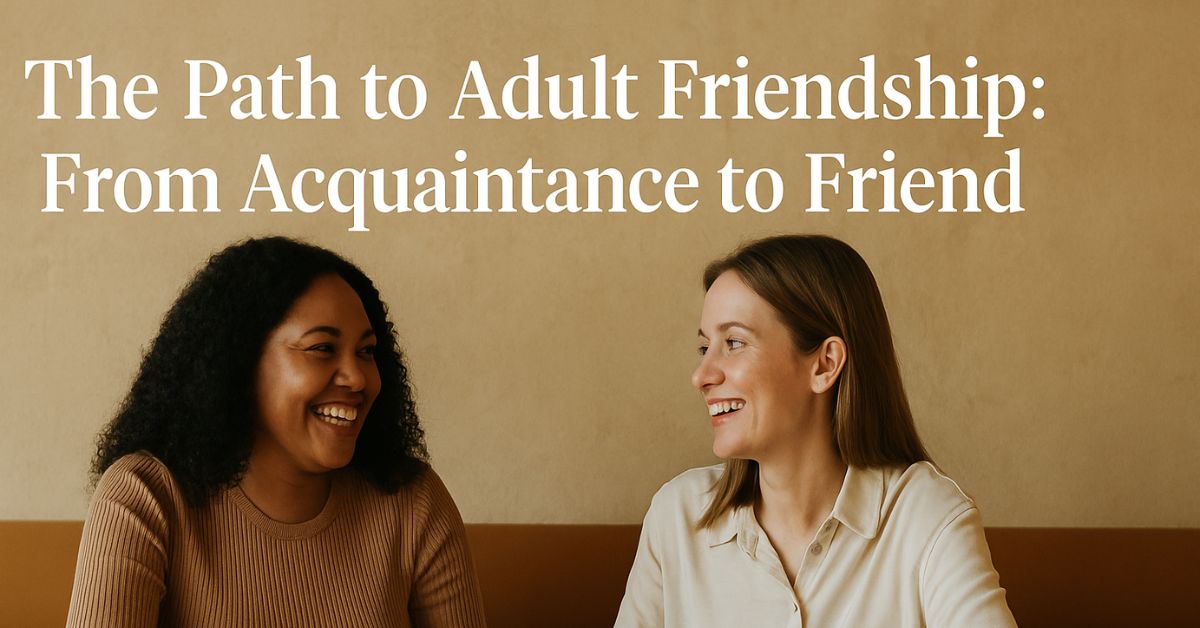Introduction
Friendship in adulthood often feels like a slow, uncertain dance. We meet people at work, the gym, classes, or community events — we chat, we smile, and we part ways. Some of these connections fade quickly, while others begin to linger. The question then arises: Is this person just an acquaintance, or could they become a real friend?
If you’ve ever wondered how to bridge that gap — or found yourself struggling to move beyond polite small talk — you’re not alone. For many adults, especially those who are neurodivergent or living with ADHD, forming deep friendships can feel both confusing and intimidating. But the good news? Friendship is a skill — one that grows with awareness, effort, and time.
Acquaintance vs. Friendship: What’s the Difference?
Before we can form lasting bonds, it helps to understand the difference between a friend and an acquaintance.
An acquaintance is someone you know casually — a neighbor you greet, a coworker you chat with at lunch, or a classmate you share jokes with but rarely see outside that setting. Your relationship is pleasant but limited to a specific context.
A friend, on the other hand, is someone with whom you share trust, support, and genuine care. You talk about life beyond work or hobbies, you make plans to see each other intentionally, and you both invest emotionally in the connection.
Put simply:
- An acquaintance is someone you know.
- A friend is someone who knows you.
So, what is the difference between friendship and friendly?
Being friendly means showing kindness and openness to others — but it doesn’t always mean there’s a deeper relationship. Friendship goes beyond politeness; it’s built on consistency, trust, and shared experiences.
And is an acquaintance higher than a friend? Not quite. Friendship sits at a higher emotional level — it takes more time, vulnerability, and effort than an acquaintanceship.
Signs Someone Wants to Be Your Friend
Many adults struggle to read the social signals that hint someone wants to move from acquaintance to friendship. Luckily, there are subtle clues that show mutual interest:
- They initiate conversations — it’s not always you making the first move.
- They remember small details about your life and follow up later (“Hey, how did that interview go?”).
- They linger after activities — maybe chatting in the parking lot or walking out together after class.
- They make references to you in their day-to-day life, like “I thought of you when I saw this funny video.”
- They suggest spending time together outside your usual setting.
These little moments — when someone goes beyond surface-level politeness — often mark the first steps toward real friendship.
How to Bridge the Gap: Turning Acquaintances into Friends
Transitioning from casual connection to true friendship takes time, consistency, and courage. Here are some simple, low-pressure ways to make it happen:
- Extend your shared context.
If you met in a fitness class, invite them for a post-workout smoothie.
If you bonded over art, suggest visiting a new exhibit together. - Take small social risks.
Try inviting them to a casual, low-stakes activity — like grabbing coffee, going for a walk, or attending a local event. - Show genuine curiosity.
Ask open-ended questions about their interests or daily life. People feel connected when they’re seen and heard. - Follow up and check in.
A simple text like “I really enjoyed our chat today!” or “Want to do that again next week?” helps build continuity. - Be patient.
Deep friendships don’t form overnight. Regular contact, shared laughter, and small moments of vulnerability weave the foundation over time.
Is It Better to Have Friends or Acquaintances?
Both play important roles in our social well-being.
- Acquaintances bring variety, light conversation, and new perspectives — great for expanding your social world.
- Friends, however, provide emotional depth, mutual support, and belonging.
A balanced social circle often includes both. You don’t need a large group of close friends to feel fulfilled — just a few people with whom you can be your authentic self.
Hope and Patience in Adult Friendships
If forming friendships feels slow or uncertain, remember: you’re not behind — you’re human. Life changes, schedules clash, and emotional energy ebbs and flows. True friendship often grows quietly, through repeated moments of connection and kindness.
Be patient — with others and with yourself. Each smile, shared story, or text is a small thread weaving something meaningful. With time, effort, and openness, acquaintances can become trusted friends — the kind who make adulthood brighter, lighter, and infinitely more human.
Frequently Asked Questions (FAQ)
- What is the difference between a friend and an acquaintance?
An acquaintance is someone you know casually, like a coworker or neighbor, while a friend is someone you share trust, emotional closeness, and personal experiences with. Friendship goes beyond friendliness — it’s built on mutual effort and care. - Is it better to have friends or acquaintances?
Both are valuable. Acquaintances broaden your social world and offer variety, while true friends provide emotional support, comfort, and belonging. Ideally, a healthy social life includes a mix of both. - What is the difference between friendship and friendly?
Being friendly means showing kindness and openness, even to strangers. Friendship, however, involves consistency, a deeper emotional connection, and shared trust over time. - Is an acquaintance higher than a friend?
No. Friendship is a deeper, more meaningful relationship than acquaintanceship. Acquaintances may share common spaces or activities, while friends intentionally connect and support one another beyond those contexts. - How can you turn an acquaintance into a friend?
Start with small, low-risk interactions like grabbing coffee or chatting after class. Show interest in their life, follow up regularly, and be patient. Over time, these consistent moments build trust and closeness.




